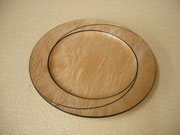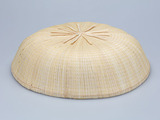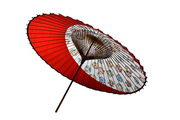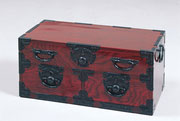Iwate and more
- Sort by
- Popularity
- Name
-
Nambu ironware Nambu tekki
- Metal works
- Iwate

Nambu Ironware (called Nambu tekki in Japanese) is a form of metalwork produced in Morioka City and Mizusawa, Oshu City in Iwate prefecture. It is a traditional craft that was first created in the middle of the Edo period (1603-1868). The name �…
View more
-
Mino ware Mino yaki
- Ceramic
- Gifu

Mino ware (called Mino yaki in Japanese) is a ceramic ware produced in the Tono area of Gifu prefecture. It has a long history and tradition but has adapted to modern life style. A notable feature of Mino ware is its wide variety of pottery. Mino …
View more
-
Tobe ware Tobe yaki
- Ceramic
- Ehime

Tobe ware (called Tobe yaki in Japanese) is a form of ceramic ware produced around the town of Tobe in Iyo district of Ehime prefecture. Production began in the middle of the Edo period (1603-1868) and it was registered as a traditional craft by t…
View more
-
Mino traditional Japanese paper Mino washi
- Traditional Japanese paper
- Gifu

Mino washi is a type of Japanese paper made in Gifu prefecture. Washi is made from paper mulberry which is a plant that grows in the city of Mino, a place of abundant forests. Ancient manuscripts in the Shosoin Repository* indicate the history of …
View more
-
Iwayado traditional chest Iwayado tansu
- Wood, bamboo crafts
- Iwate

Iwayado tansu is a traditional woodwork made in the cities of Oshu and Morioka, Iwate prefecture. Tansu means chest of drawers. In addition to clothing or organization chests, daily use items like tea cabinets, book shelves, and low tables are mad…
View more
-
Takaoka copperware Takaoka doki
- Metal works
- Toyama

Takaoka copperware (called Takaoka doki in Japanese) is a type of copperware produced in the area around the city of Takaoka in Toyama prefecture. The various products range from small items such as indoor ornaments, Buddhist tools, and vases to l…
View more
-
Inami wood carvings Inami chokoku
- Wood, bamboo crafts
- Toyama

Inami woodcarvings (called Inami chokoku in Japanese) are produced in the city of Nanto, Toyama prefecture mainly in the form of transoms*, decorative objects, and single-leaf screens**. They are usually made of Japanese camphor, paulownia, or zel…
View more
-
Joboji lacquerware Joboji nuri
- Lacquerware
- Iwate

Joboji lacquerware (called Joboji nuri in Japanese) is produced in the town of Joboji in Iwate prefecture. More than 98% of the lacquer used in Japan is imported from China or other countries. The Joboji area is known as the leading producer of do…
View more
-
Ogatsu inkstone Ogatsu suzuri
- Writing tools
- Miyagi

Ogatsu inkstone (called Ogatsu suzuri in Japanese) is a craft produced in the former town of Ogatsu (now city of Ishinomaki), Miyagi prefecture, where artisans still carefully hand carve and polish every piece. What is unique to Ogatsu inkstone i…
View more
-
Gifu lanterns Gifu chochin
- Other crafts
- Gifu

Gifu lanterns (called Gifu chochin in Japanese) are produced in the city of Gifu, Gifu prefecture and have a history of over three hundred years. In 1995, their high level of craftsmanship was recognized with a designation as a National Traditiona…
View more
-
Hidehira lacquerware Hidehira nuri
- Lacquerware
- Iwate

Hidehira lacquerware (called Hidehira-nuri in Japanese) is produced in the area around the town of Hiraizumi, in Iwate prefecture. The defining feature of Hidehira lacquerware is the use of gold leaf produced in the area around Hiraizumi, which re…
View more
-
Ichii woodcarvings Ichii itto bori
- Wood, bamboo crafts
- Gifu

Ichii woodcarvings (called Ichii itto bori in Japanese) are produced in the Hida region of Gifu prefecture, and made only from the wood of ichii (Japanese yew), the prefectural tree of Gifu. The ichii tree gets its name from a scepter made of Japa…
View more
-
Takaoka lacquerware Takaoka shikki
- Lacquerware
- Toyama

Takaoka lacquerware (called Takaoka shikki in Japanese) is produced in the area around the city of Takaoka, in Toyama prefecture. A defining feature of this lacquerware is the wide range of techniques and styles. Aogai-nuri is a technique that use…
View more
-
Hida-shunkei lacquerware Hida shunkei
- Lacquerware
- Gifu

Hida-shunkei lacquerware is produced around the city of Takayama in Gifu prefecture. The name is said to come from the fact that the articles produced initially had a similar coloring to Hishunkei tea containers. This craft is notable for having …
View more
-
Naruko lacquerware Naruko shikki
- Lacquerware
- Miyagi

Naruko lacquerware (called Naruko shikki in Japanese) is a form of lacquerware produced around the city of Osaki, Miyagi prefecture. Lacquerware is a craft coating layers of lacquer on wooden tableware and other utensils. Lacquerware is produced i…
View more
-
Ozu traditional Japanese paper Ozu washi
- Traditional Japanese paper
- Ehime

Ozu traditional Japanese paper (called Ozu washi in Japanese) is a handmade paper made in the town of Uchiko, Ehime prefecture. The history of papermaking of Ozu washi dates back to the Heian period (794-1185), and the current style of Ozu washi e…
View more
-
Echu traditional Japanese paper Echu washi
- Traditional Japanese paper
- Toyama

Etchu washi is traditional Japanese paper made in Asahi, Yatsuo, and Taira in Toyama prefecture. Each production area makes their own type of washi which are called Gokayama washi, Yatsuo washi, and Birudan washi. This craft has slight regional va…
View more
-
Miyagi kokeshi doll Miyagi dento kokeshi
- Dolls, kokeshi
- Miyagi

Miyagi Kokeshi Dolls (called Miyagi Dento Kokeshi in Japanese) are wooden dolls produced in and around the cities of Sendai and Shiraishi, Miyagi prefecture. Categorized based on region into five styles including Naruko kokeshi and Togatta kokeshi…
View more
-
Nibutani carved wooden tray Nibutani ita
- Wood, bamboo crafts
- Hokkaido

Nibutani Carved Wooden Trays (called Nibutani ita in Japanese) are produced in Biratori, Hokkaido. The origin of the town name, is an Ainu language word for cliff, pirauturu. This craft is known for its patterns like a spiral pattern called moreun…
View more
-
Nibutani bark cloth Nibutani attoushi
- Woven textiles
- Hokkaido

Nibutani Bark Cloth (called Nibutani-attushi in Japanese) is a bark fiber fabric produced in the region surrounding the the town of Biratori, Hokkaido. The term Nibutani originates from niputai which is an Ainu (indigenous people of north Japan) l…
View more
-
Shogawa woodcraft Shogawa hikimono kiji
- Industrial art materials and tools
- Toyama

Shogawa woodcrafts are mostly woodcraft articles such as bowls or trays made in a wide area of the Toyama Prefecture including the city of Takaoka and the city of Tonami. Shogawa woodcrafts were designated as a traditional craft by the Ministry of…
View more
-
Etchu Fukuoka Sedge Hats Etchu Fukuoka no suge gasa
- Other crafts
- Toyama

Etchu Fukuoka no suge gasa, Etchu Fukuoka Sedge Hats, are a traditional craft produced in Takaoka, Tonami, Oyabe, and Nanto of Toyama prefecture. The sedges produced in Fukuoka, Toyama are top quality as they survive the severe winters of the Hok…
View more
-
Gifu Japanese Umbrellas Gifu Wagasa
- Other crafts
- Gifu

Japanese umbrellas are not only used on rainy days or as parasols, but there are also umbrellas used for dancing and larger parasols called nodategasa used for outdoor tea ceremonies. They become very slim and delicate when they are closed, and t…
View more
-
Sendai traditional chest Sendai tansu
- Wood, bamboo crafts
- Miyagi

Sendai tansu is a type of chest of drawers made in the city of Sendai, Miyagi prefecture. Usually they are made of Japanese chestnut, cedar, and zelkova wood, and renowned for their highly ornamented iron fittings and three different types of beau…
View more
- 1































































































































































































































































































